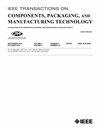Accelerated Life Test and Prediction of Electromigration in Aluminum Interconnects Coupling Multiphysics Full Coupled Model With Optimized Atomic Flux Divergence Simulation
IF 3
3区 工程技术
Q2 ENGINEERING, ELECTRICAL & ELECTRONIC
IEEE Transactions on Components, Packaging and Manufacturing Technology
Pub Date : 2025-03-26
DOI:10.1109/TCPMT.2025.3554259
引用次数: 0
Abstract
With the miniaturization and high-power requirements of microelectronic devices, the current density carried by interconnects in packaging structures continually increases and reaches the threshold of electromigration (EM) failure. In this study, we investigated the microstructure evolution and void formation in aluminum (Al) interconnects during EM at three different current densities (1/3/5 MA/cm2) and proposed a method coupling the fully coupled theory with an optimized atomic flux divergence method. The results show as follows. First, for the interconnects in integrated circuits, current density is the main factor affecting the EM lifetime of the interconnects in a certain temperature range. With the gradual increase of current density, the contribution of thermal transfer on EM cannot be ignored. The atomic concentration gradient and stress gradient can inhibit EM failure. Second, the increase of length and the decrease of width of interconnect will lead to the increase of atomic flux inside the structure, resulting in the accumulation of voids and atoms. Third, the structure is dynamically reconstructed after deleting the atoms below the failure threshold and the simulation results agree well with the experimental results. Compared with the traditional atomic flux divergence method, the improved atomic flux divergence method based on the fully coupled theory can better fit the change trend of atomic concentration after interconnect failure, and the failure time error is reduced by about 10%.基于优化原子通量发散模拟的铝互连耦合多物理场全耦合模型电迁移加速寿命试验与预测
随着微电子器件小型化和高功率化的要求,封装结构中互连所携带的电流密度不断增大,达到电迁移失效的阈值。在本研究中,我们研究了三种不同电流密度(1/3/5 MA/cm2)下铝(Al)互连体的微观结构演变和空洞形成,并提出了一种将完全耦合理论与优化原子通量发散方法相结合的方法。结果表明:首先,对于集成电路中的互连来说,电流密度是影响互连在一定温度范围内EM寿命的主要因素。随着电流密度的逐渐增大,热传递对电磁效应的贡献不可忽视。原子浓度梯度和应力梯度可以抑制电磁破坏。其次,互连长度的增加和宽度的减小将导致结构内部原子通量的增加,从而导致空隙和原子的积累。第三,剔除失效阈值以下原子后动态重构结构,仿真结果与实验结果吻合较好。与传统的原子通量散度方法相比,基于全耦合理论的改进原子通量散度方法能更好地拟合互连失效后原子浓度的变化趋势,失效时间误差减小约10%。
本文章由计算机程序翻译,如有差异,请以英文原文为准。
求助全文
约1分钟内获得全文
求助全文
来源期刊

IEEE Transactions on Components, Packaging and Manufacturing Technology
ENGINEERING, MANUFACTURING-ENGINEERING, ELECTRICAL & ELECTRONIC
CiteScore
4.70
自引率
13.60%
发文量
203
审稿时长
3 months
期刊介绍:
IEEE Transactions on Components, Packaging, and Manufacturing Technology publishes research and application articles on modeling, design, building blocks, technical infrastructure, and analysis underpinning electronic, photonic and MEMS packaging, in addition to new developments in passive components, electrical contacts and connectors, thermal management, and device reliability; as well as the manufacture of electronics parts and assemblies, with broad coverage of design, factory modeling, assembly methods, quality, product robustness, and design-for-environment.
 求助内容:
求助内容: 应助结果提醒方式:
应助结果提醒方式:


